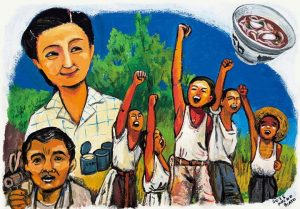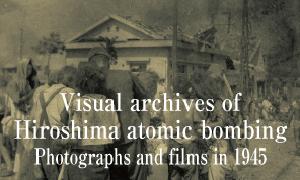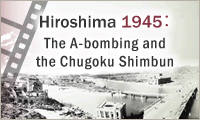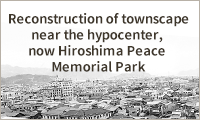Hiroshima and Film, Part 13: Toru Mizoguchi―Manager of Yokogawa Cinema
Jul. 12, 2025
“Aoba Gakuen Monogatari” Director: Yutaka Osawa (Released in 1981)
Cheerful and vigorous A-bomb orphans
I cannot recall how I found it. Maybe it was in the school library, or my mother recommended it to me. I came across the original “Aoba Gakuen Monogatari” (in English, ‘Story of the Aoba children’s home’), a series written by the children’s author Naoshiro Yoshimoto who incorporated his autobiographical elements within it, when I was in the third grade of elementary school. The story takes place at the Aoba Gakuen, a children’s home established for A-bomb orphans, vividly depicting the various uproar caused by the children and their leader, Kazuhiko, a sixth grader, who lives in the Natsume dormitory.
At the Aoba Gakuen, which is their family and society, children rack their brains and let themselves get carried away, as if trying to dispel the poverty of the postwar period and loneliness of living without their parents. They are not discouraged even if they fail, and share their joys and sorrows with each other. I longed for their free, vigorous, and kind communal life, as well as for the presence of peers of my age. I was absorbed in reading the three books that had already been published. I remember dashing to the copies of the new book stacked flat in a bookstore in Kabe (Asakita Ward, Hiroshima City), where I lived at that time, when I saw its cover on the day of the eagerly awaited release of the new story.
The live-action movie was entirely shot on location in Hiroshima in 1980. My investigation found that the movie’s general release was in January of the following year at the Hiroshima Meigaza, a theater that used to be located on the eighth floor of the present Fukuya department store’s Hacchobori main store, which was also the location of the movie. I think I went to the theater during the winter break or the third term of my fourth year of elementary school.
The restructured movie version, which is condensed into the drama of a summer, maintains the same episodes and lively Hiroshima dialect dialogue as the original. It starts with the scene of Sachiko and her younger brother, Shinji, being taken into the Natsume dormitory because their mother has become sick. One day, the children’s council was thrown into confusion over how to make use of the money they had obtained from selling a pig they had raised; the boys wanted to buy baseball equipment, while the girls insisted on getting something that everyone could use. In the end, the boys were outvoted, and their dream of getting baseball equipment was dashed. They formed the “Shitamuki gaisha” (Downward look company) and worked hard, picking up iron scraps.
The children go downtown cheerfully to eat something delicious with the money they earned. However, the shop they finally entered was an Udon noodle shop run by an elderly couple who had lost their family members in the atomic bombing. “Your story is depressing, and the Udon noodle soup is lukewarm,” Kazuhiko uses abusive language, yet he leaves all the money he had on hand at the shop without consulting others. The warped feelings of Kazuhiko and the innocence of the children, who praise him, saying, “You did a good thing, Kazuhiko,” are shown there. Set eight years after the atomic bombing and the end of the war, the movie is full of cheerfulness and brightness. This is probably because the children’s independent identity and growth, overlapping with the buds of postwar democracy, are depicted in a positive way.
Coincidentally, the movie was produced in 1980, when the “10 Feel Film Project,” a Japanese campaign to purchase A-bomb documentary films from the United States, began. I donated one share of 3,000 yen, and attended the screening of the completed film at the Kenshin Kodo (Kenshin auditorium). I remember an old man I did not know shaking my hand vigorously as I was leaving. Maybe he was pleased to see an elementary school student come alone to watch the film.
Looking back, I was very fortunate to be able to physically experience the will for anti-nuclear weapons and peace that the grassroots Hiroshima citizens put into the dramatic films from Hiroshima, “Aoba Gakuen Monogatari” and the “10 Feet Film Project” documentary films, when I was at a susceptible age.
Toru Mizoguchi
Born in 1970 in Minami Ward, Hiroshima City. While still a student, he worked part time for Hiroshima Toei and Takanobashi Nichigeki. He then joined Hiroshima Station Cinema, where he independently planned late-night showings. After the closure of the Hiroshima Station Cinema, he moved to the Yokogawa Cinema in 1999, where he has managed overall theater operations ever since.
Hato
Born in Otake City in 1981. Her real name is Keiko Hata. She creates a wide range of formative arts, including painting, graphic design, stop-motion animation, and theatrical art.
Information on the film
Japan / 100 min. / Planned by Hiroshima Eiga Center
[Screenplay] Eiko Yoshida, Yutaka Osawa
[Music] Koichi Morita
[Cinematography] Shun Yamamoto
[Lighting] Yoshihara Yamamoto
[Art] Shigekazu Ikuno
[Recording] Tetsuya Ohashi
[Editor] Eiko Yoshida
[Performer] Yoshie Ichige, Mizuho Suzuki, Makoto Akatsuka, Minako Osanai, Moeko Ezawa, Kazuo Iwaki, Kai Ato, Nikaku Shofukutei, Yoshi Kato
(Originally published on July 12, 2025)








